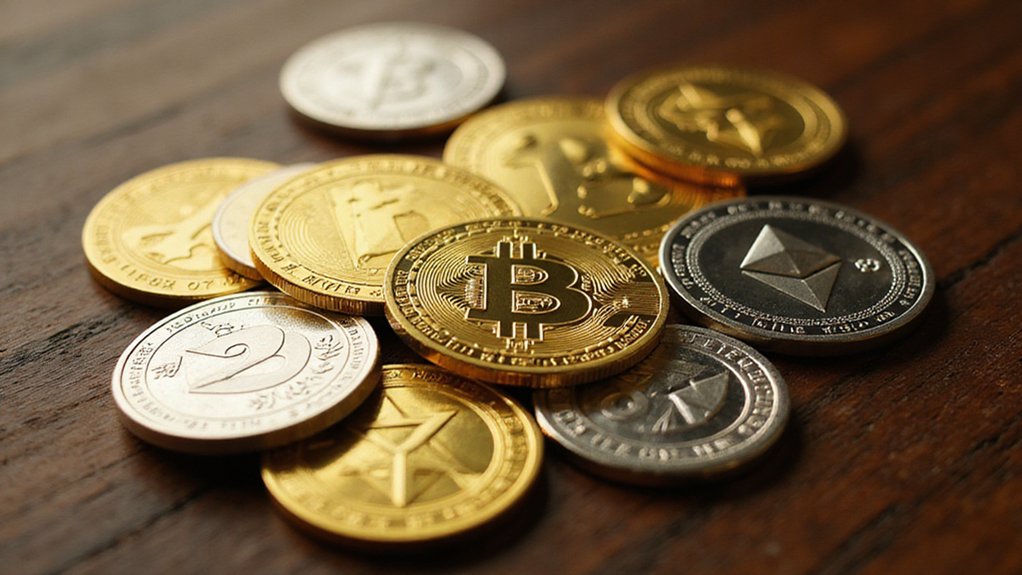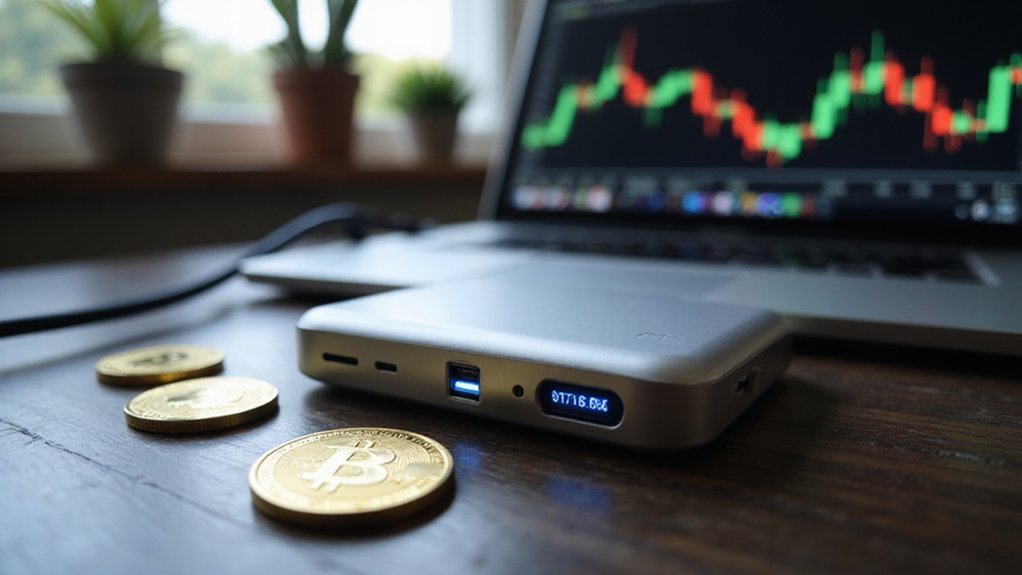DeFi (decentralized finance) represents blockchain technology’s ambitious attempt to reconstruct traditional banking through smart contracts and peer-to-peer protocols, eliminating intermediaries while offering lending, borrowing, and trading services on public blockchains like Ethereum. This permissionless ecosystem operates through algorithmic precision rather than human gatekeepers, allowing global participation via wallet addresses and pseudonymous transactions. Though the sector has grown from $1 billion to over $120 billion in total value locked, smart contract vulnerabilities and regulatory uncertainty persist alongside the revolutionary potential that continues below.

What happens when traditional banking‘s centuries-old gatekeeping apparatus meets blockchain technology‘s radical promise of disintermediation? The answer is decentralized finance (DeFi)—a peer-to-peer financial ecosystem that audaciously suggests we might not need banks after all.
DeFi operates primarily on public blockchains like Ethereum, utilizing smart contracts to automate financial agreements without human intermediaries. These self-executing contracts enforce coded terms with algorithmic precision, creating a permissionless environment where anyone with internet access can participate in global financial markets. The system’s pseudonymous nature allows users to transact through wallet addresses rather than surrendering personal information to yet another institution demanding documentation.
The platform offers traditional financial services with distinctly non-traditional characteristics. Users can lend cryptocurrency assets for interest, borrow against collateral, or trade on decentralized exchanges (DEXs) that facilitate direct peer-to-peer transactions. More sophisticated participants engage in yield farming¹ and derivatives trading, while others simply park assets in “vaults” or “pools” that function as interest-bearing savings accounts—albeit with considerably more complexity than your neighborhood credit union. The linked blocks structure ensures that all transaction records remain chronologically ordered and resistant to modification.
DeFi’s technological foundation rests on blockchain’s distributed ledger system, supported by oracle networks that feed external data to smart contracts. The ecosystem’s composability allows protocols to integrate seamlessly, creating an interconnected web of financial services that can theoretically build upon each other indefinitely. The sector’s remarkable growth trajectory shows total value locked expanding from $1 billion in 2020 to over $120 billion by 2025.
The benefits appear compelling: reduced costs through eliminated intermediaries, faster transaction processing, unprecedented transparency, and financial inclusion for the traditionally underbanked. However, this utopian vision confronts sobering realities. Smart contract vulnerabilities have enabled spectacular hacks, while regulatory uncertainty leaves users exposed to fraud and manipulation. The cryptocurrency markets‘ notorious volatility creates additional risks, including impermanent loss for liquidity providers. DeFi users maintain complete control over their assets through private keys stored in personal wallets, eliminating the need to trust centralized custodians with fund management.
Perhaps most ironically, DeFi’s promise of simplified finance places enormous responsibility on users to manage private keys and navigate complex protocols. The trillion-dollar industry continues expanding despite—or perhaps because of—these challenges, as traditional financial institutions increasingly explore integration with decentralized systems while regulators worldwide scramble to establish appropriate oversight frameworks.
¹ The practice of moving assets between protocols to maximize returns—a euphemism for sophisticated speculation.
Frequently Asked Questions
How Much Money Do I Need to Start Using Defi Platforms?
DeFi platforms technically accept investments as modest as a few dollars, though practical considerations suggest otherwise.
While protocols themselves impose minimal barriers, Ethereum’s notorious gas fees can devour small positions entirely—rendering micro-investments economically absurd.
Seasoned practitioners recommend $10,000 minimum for meaningful diversification and strategy implementation.
However, ambitious investors eyeing specialized funds like Bitwise’s offerings face $25,000 thresholds, because apparently even decentralized finance maintains its own exclusive clubs.
What Are the Tax Implications of Earning Money Through Defi Protocols?
DeFi earnings trigger multiple taxable events—staking rewards constitute ordinary income at receipt, while token swaps generate capital gains obligations.
Short-term gains face marginal rates up to 37%, whereas long-term positions enjoy preferential treatment at 0-20%.
Starting 2025, enhanced IRS reporting requirements increase enforcement scrutiny.
Each protocol interaction demands meticulous record-keeping for fair market valuations.
The tax complexity often exceeds the yields themselves, making professional guidance essential for compliance.
Can I Lose All My Money if a Defi Platform Gets Hacked?
Yes, investors can lose their entire stake when DeFi platforms suffer security breaches.
With $10.77 billion lost across the top 100 DeFi hacks since 2014, the risk proves substantial.
Unlike traditional banking, DeFi offers no deposit insurance or transaction reversals.
Smart contract vulnerabilities, private key compromises, and governance attacks can drain user funds completely.
Some platforms reimburse victims, but recovery remains uncommon—caveat emptor applies with particular force here.
Which Defi Platforms Are Considered the Safest for Beginners to Use?
For beginners prioritizing safety, established platforms like Uniswap, Aave, and MakerDAO offer the most reliable entry points—their extensive track records and robust security audits provide reassurance amid DeFi’s inherent volatility.
Pairing these with reputable wallets like Best Wallet for software solutions or Ledger hardware devices creates additional protection layers.
While no platform guarantees absolute safety (given our previous hacking discussion), these represent the industry’s safest options for cautious newcomers.
How Do I Recover My Funds if I Send Them to Wrong Address?
Fund recovery depends entirely on the recipient’s cooperation and address validity—blockchain’s immutable nature offers no customer service hotline.
Contact the recipient directly if the address belongs to another user, or reach exchange support if funds landed in their wallets.
Cross-chain tools might salvage assets sent to wrong networks, though success remains dubious.
Prevention through meticulous address verification beats recovery attempts, given that most erroneous transactions become expensive lessons in digital permanence.









